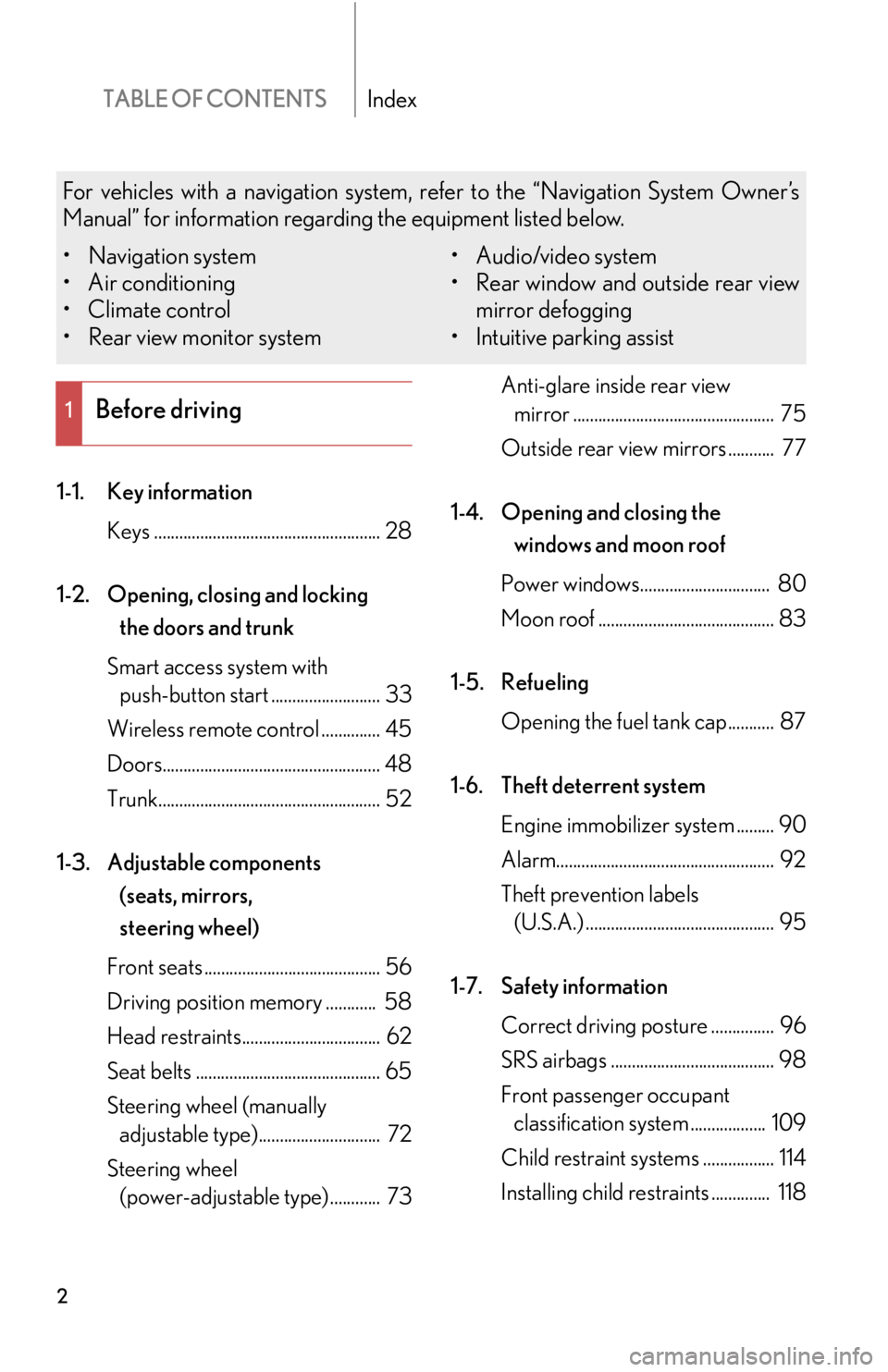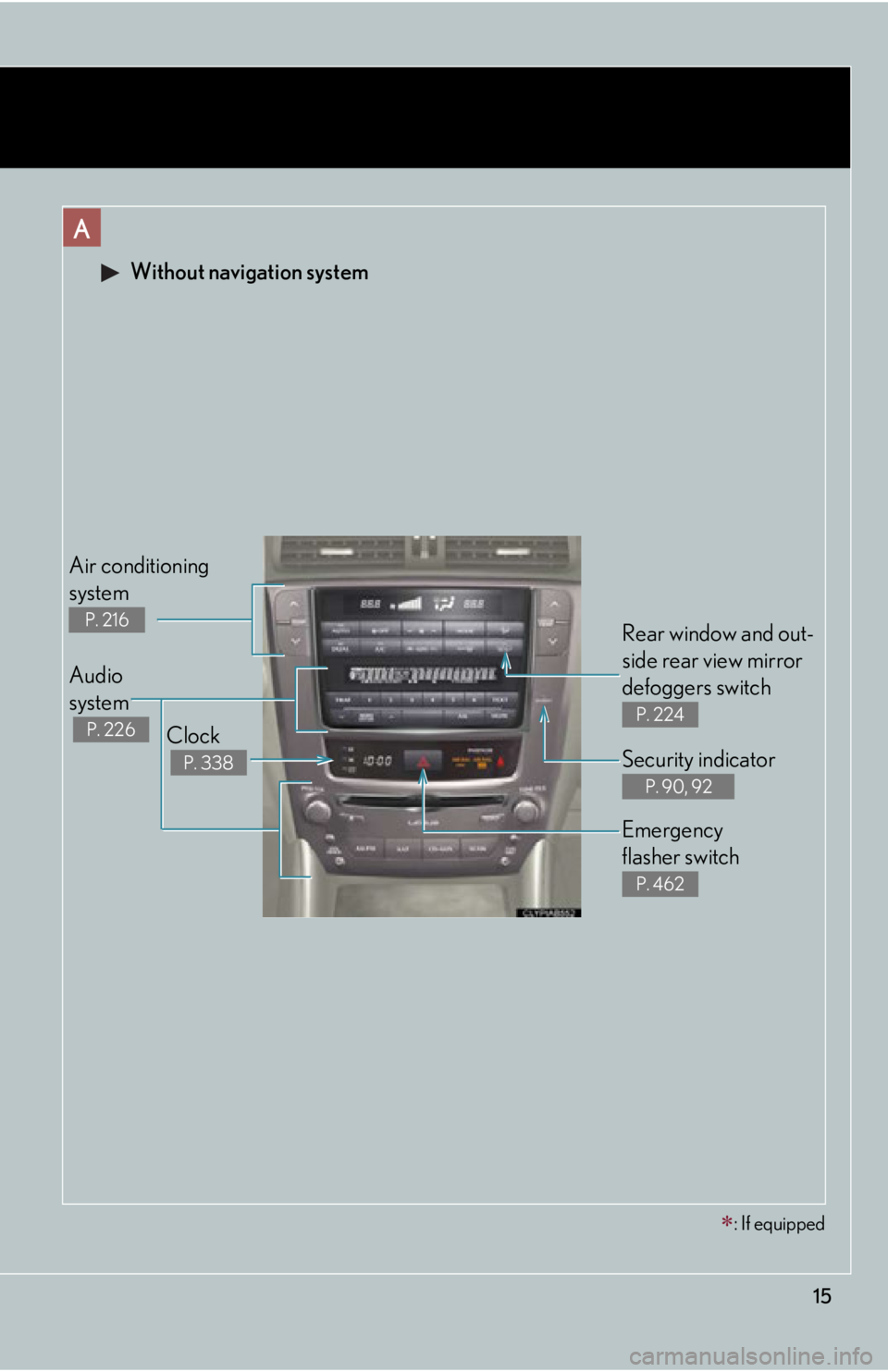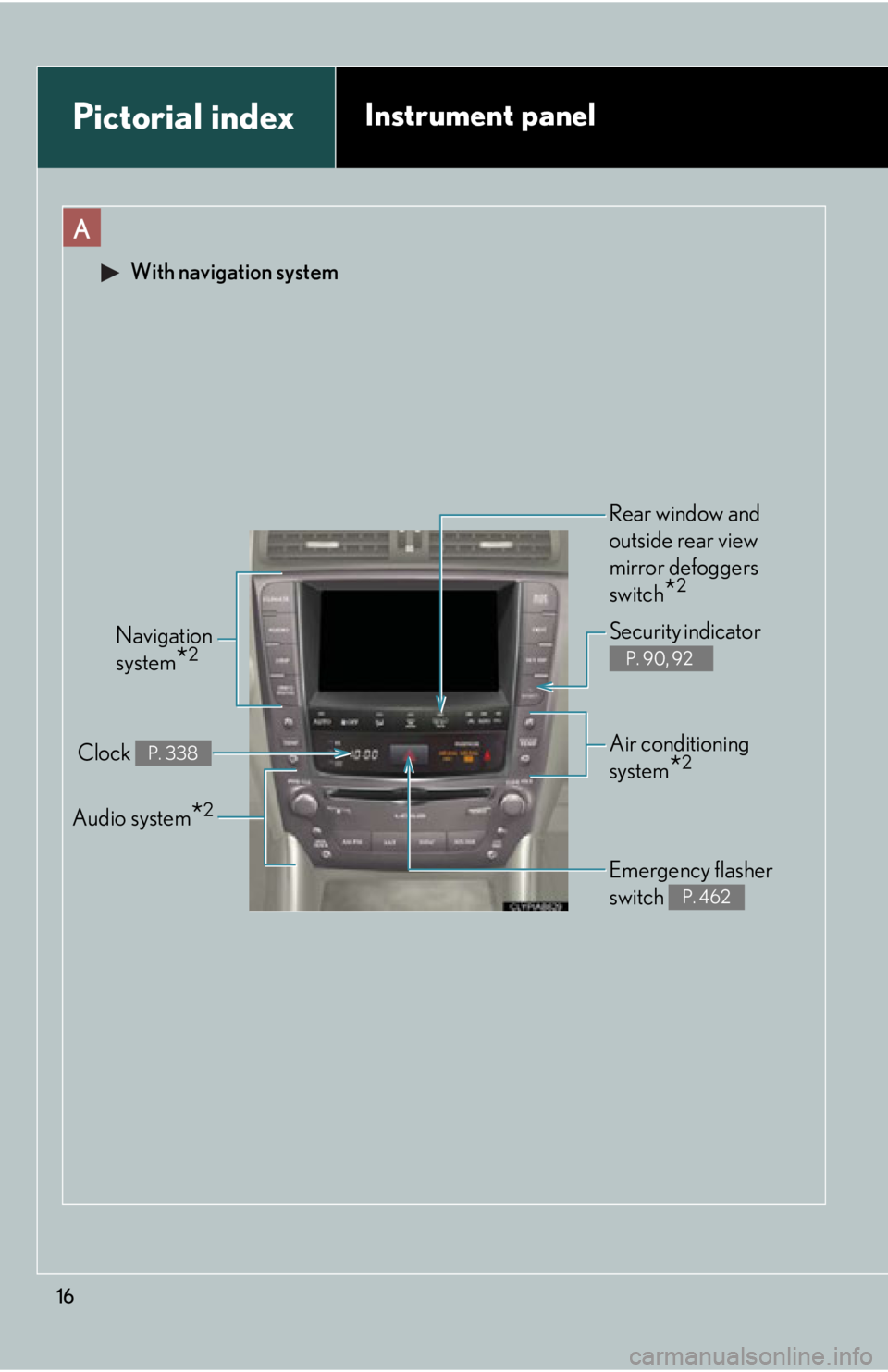audio Lexus IS250 2012 Using the Bluetooth audio system / LEXUS 2012 IS250,IS350 OWNERS MANUAL (OM53A87U)
[x] Cancel search | Manufacturer: LEXUS, Model Year: 2012, Model line: IS250, Model: Lexus IS250 2012Pages: 592, PDF Size: 6.2 MB
Page 1 of 592

TABLE OF CONTENTS
1
1Before drivingAdjusting and operating features such as door locks, mir-
rors, and steering column.
2When drivingDriving, stopping and safe-driving information.
3Interior featuresAir conditioning and audio systems, as well as other interior
features for a comfortable driving experience.
4Maintenance
and careCleaning and protecting your vehicle, performing do-it-your-
self maintenance, and maintenance information.
5When trouble
arisesWhat to do if the vehicle needs to be towed, gets a flat tire,
or is involved in an accident.
6Vehicle
specificationsDetailed vehicle information.
7For ownersReporting safety defects for US owners, and seat belt and
SRS airbag instructions for Canadian owners.
IndexAlphabetical listing of informat ion contained in this manual.
Page 2 of 592

TABLE OF CONTENTSIndex
2
1-1. Key informationKeys ...................................................... 28
1-2. Opening, closing and locking the doors and trunk
Smart access system with push-button start .......................... 33
Wireless remote control .............. 45
Doors.................................................... 48
Trunk..................................................... 52
1-3. Adjustable components (seats, mirrors,
steering wheel)
Front seats .......................................... 56
Driving position memory ............ 58
Head restraints................................. 62
Seat belts ............................................ 65
Steering wheel (manually adjustable type)............................. 72
Steering wheel (power-adjustable type)............ 73 Anti-glare inside rear view
mirror ................................................ 75
Outside rear view mirrors ........... 77
1-4. Opening and closing the windows and moon roof
Power windows............................... 80
Moon roof .......................................... 83
1-5. Refueling Opening the fuel tank cap........... 87
1-6. Theft deterrent system Engine immobilizer system ......... 90
Alarm.................................................... 92
Theft prevention labels (U.S.A.) ............................................. 95
1-7. Safety information Correct driving posture ............... 96
SRS airbags ....................................... 98
Front passenger occupant classification system .................. 109
Child restraint sy stems ................. 114
Installing child restraints .............. 118
1Before driving
For vehicles with a navigation system, refer to the “Navigation System Owner’s
Manual” for information regarding the equipment listed below.
• Navigation system
• Air conditioning
• Climate control
• Rear view monitor system • Audio/video system
• Rear window and outside rear view
mirror defogging
• Intuitive parking assist
Page 4 of 592

TABLE OF CONTENTSIndex
4
3-1. Using the air conditioning system and defogger
Automatic air conditioning system ............................................. 216
Rear window and outside rear view
mirror defoggers ....................... 224
Windshield wiper de-icer ......... 225
3-2. Using the audio system Audio system type ....................... 226
Using the radio .............................. 229
Using the CD player ................... 237
Playing back MP3 and WMA discs .................................. 244
Operating an iPod ....................... 252
Operating a USB memory...... 260
Optimal use of the audio system ............................................ 269
Using the AUX port..................... 271
Using the steering wheel audio switches ............................ 273 3-3. Using the Bluetooth
® audio
system
Bluetooth
® audio system ......... 276
Using the Bluetooth
®
audio system................................ 279
Operating a Bluetooth
®
enabled portable player ......... 284
Setting up a Bluetooth
®
enabled portable player ......... 287
Bluetooth
® audio system
setup ............................................... 293
3-4. Using the hands-free phone system (for mobile phones)
Hands-free system for mobile phones ........................................... 294
Using the hands-free system (for mobile phones) ................. 298
Making a phone call................... 306
Setting a mobile phone ............... 310
Security and system setup ......... 315
Using the phone book................. 319
3-5. Using the interior lights Interior lights list............................ 325
• Interior lights ............................... 327
• Personal lights ............................ 327
3Interior features
Page 14 of 592

14
Pictorial indexInstrument panel
Headlight switch Turn signal lever Fog light switch P. 172
P. 154
P. 176
Shift paddle switches (a utomatic transmission) P. 147, 149
Gauges and meters P. 158
Multi-information display P. 167
Windshield wiper and washer switch P. 178
Engine (ignition) switch P. 141
Trunk opener main switch P. 52
Glove box P. 329
Tilt and telescopic steering lock release lever P. 72
Tilt and telescopic steering control switch P. 73
Parking brake pedal (automatic transmission) P. 155
Audio remote control switches P. 273
Horn P. 157
Hood release lever P. 394
Page 15 of 592

15
Without navigation system
Clock
P. 338
Audio
system
P. 226
Air conditioning
system
P. 216Rear window and out-
side rear view mirror
defoggers switch
P. 224
Security indicator
P. 90, 92
Emergency
flasher switch
P. 462
: If equipped
A
Page 16 of 592

16
Navigation
system
*2
Clock P. 338
Audio system*2
Security indicator
P. 90, 92
Emergency flasher
switch
P. 462
Air conditioning
system
*2
With navigation system
Rear window and
outside rear view
mirror defoggers
switch
*2
A
Pictorial indexInstrument panel
Page 31 of 592

31
1-1. Key information
1
Before driving
NOTICE
■To prevent key damage
Observe the following.
●Do not drop the keys, subject them to strong shocks or bend them.
●Do not expose the keys to high temperatures for a long period of time.
●Do not get the keys wet or wash them in an ultrasonic washer etc.
●Do not attach metallic or magnetic materials to the keys or place the keys close to
such materials.
●Do not disassemble the electronic keys.
●Do not attach stickers that contain materials that block radio waves, such as
metallic materials, to the key.
●Do not place the keys near objects that produce magnetic fields, such as TVs,
audio systems, glass top ranges, or medical electrical equipment, such as low-fre-
quency therapy equipment.
■Precautions for handling the card keys
●Do not apply excess force when inserting the mechanical key to the card key.
Doing so may damage the card key.
●If the battery or card key terminals get wet, the battery may corrode and the card
key may stop working.
If the key is dropped into water, or if drinking water etc. is spilled on the key,
immediately remove the battery cover and wipe the battery and terminals. (To
remove the battery cover, lightly grasp it and pull.) If the battery is corroded, have
your Lexus dealer replace the battery.
●Do not crush the battery cover or use a screwdriver to remove the battery cover.
Forcibly removing the battery co ver may bend or damage the key.
●If the battery cover is frequently removed, the battery cover may become loose.
●When installing the battery, make sure to check the direction of the battery.
Installing the battery in the wrong direct ion may cause the battery to deplete rap-
idly.
Page 32 of 592

32
1-1. Key information
NOTICE
●The surface of the card key may be damaged, or its coating may peel off in the
following situations.
• The card key is carried together with hard objects, such as coins or keys.
• The card key is scraped with a sharp object, such as a tip of mechanical pencil.
• The surface of the card key is wiped with thinners or benzene.
■Carrying the electronic key on your person
When carrying the key, maintain a distance of at least 3.9 in. (10 cm) from any of the
following electrical appliances with their power on. If a distance of 3.9 in. (10 cm) is
not kept, radio waves may be interfered with, causing the key to not function cor-
rectly.
• A portable radio, cellular phone, cordless phone or other wireless communi-cation device
• Personal computers or person al digital assistants (PDAs)
• Digital audio players
• Portable game systems
Page 37 of 592

37
1-2. Opening, closing and locking the doors and trunk
1
Before driving
■Operation signals
A buzzer sounds and the emergency flashers flash to indicate that the doors have
been locked/unlocked. (Locked: Once; Unlocked: Twice)
■Conditions affecting operation
The smart access system with push-button start uses weak radio waves. In the fol-
lowing situations, the communication between the electronic key and the vehicle
may be affected, preventing the smart access system with push-button start from
operating properly:
(Ways of coping: P. 505)
●When the electronic key battery is depleted
●Near a TV tower, electric power plant, gas station, radio station, large display,
airport or other facility that generates strong radio waves or electrical noise
●When carrying a portable radio, cellular phone, cordless phone or other wire-
less communication devices
●When the electronic key is in contact wi th, or is covered by the following metal-
lic objects
• Cards to which aluminum foil is attached
• Cigarette boxes that have aluminum foil inside
• Metallic wallets or bags
•Coins
• Hand warmers made of metal
• Media such as CDs and DVDs
●When multiple electronic keys are in the vicinity
●When another wireless key (that emits radio waves) is being used nearby
●When carrying or using the electronic key together with the following devices
that emit radio waves
• Another vehicle's electronic key or a wireless key that emits radio waves
• Personal computer or personal digital assistant (PDA)
• Digital audio player
• Portable game system
●If window tint with a metallic content or metallic objects are attached to the rear
window
Page 143 of 592

143
2-1. Driving procedures
2
When driving
■Changing “ENGINE START STOP” switch mode
Modes can be changed by pressing the “ENGINE START STOP”
switch with the brake pedal (vehicles with an automatic transmission)
or clutch pedal (vehicles with a manual transmission) released. (The
mode changes each time the switch is pressed.)
OFF*
The emergency flashers can be
used.
ACCESSORY mode
Some electrical components
such as the audio system can be
used.
The “ENGINE START STOP”
switch indicator turns amber.
IGNITION ON mode
All electrical components can
be used.
The “ENGINE START STOP”
switch indicator turns amber.
*: If the shift lever is in a positionother than P when turning off
the engine, the “ENGINE
START STOP” switch will be
turned to ACCESSORY mode,
not to OFF. (vehicles with auto-
matic transmission)